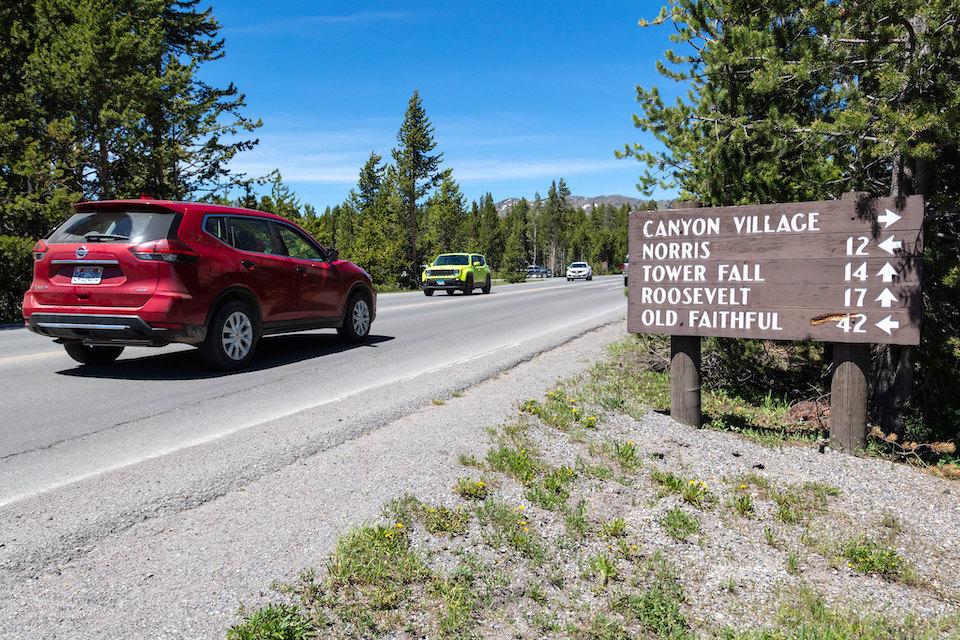
Two visitor shuttle systems will be tested in Yellowstone in 2021/NPS, Jacob W. Frank
Yellowstone National Park will test visitor shuttle systems in 2021 in a bid to relieve congestion and improve visitor services.
The shuttle initiatives include:
- Automated Shuttle Pilot: In consultation with the NPS Park Planning, Facilities and Lands Directorate and DOT, Yellowstone selected Canyon Village to test a low-speed, automated shuttle that would potentially serve the campground, visitor services, and adjoining visitor lodging area. The purpose of this pilot is to test emerging automated vehicle technology in the national park context. Exact shuttle stops, route locations and distance will be determined jointly between the park and the selected vendor, Beep Inc. Shuttles will run from late May through August of 2021. Principal parties chose Canyon Village based on visitor safety and the potential for the NPS to learn from the pilot.
- Transit Feasibility Study: In a separate study, Yellowstone is partnering with the NPS Intermountain Regional Alternative Transportation Program, the NPS Denver Service Center, and the Department of Transportation Volpe Center to analyze the opportunities, risks and costs of local shuttles possibly originating at Old Faithful and Canyon Village. Project partners will also look at potential system locations, routes, stops, fleet requirements, business models, ridership and costs. The study will include qualitative impacts to visitor experience, safety, park operations, resources and stakeholders. The park expects the study will conclude in 2022. The outcome of the study will inform whether piloting a local transit service in Yellowstone is feasible.
“Yellowstone and the NPS are proactively engaging with emerging transportation technologies by looking for ways to test, pilot and learn from these capabilities,” said Superintendent Cam Sholly. “We will continue exploring possible ways to reduce congestion and to improve visitor experience and access in heavily travelled areas of the park.”
Transportation studies conducted in 2016 and 2018, as well as a recent visitor use study, indicate that impacts from increased visitation occur primarily during peak season in roadways and attraction sites in the most popular areas of the park (West Entrance to Madison Junction, Madison Junction to Old Faithful, Old Faithful to West Thumb, Madison Junction to Norris Junction, and Norris Junction to Canyon Village). These roadways and parking areas are over-capacity by about 29% during peak season (July) conditions.
As a result, the park has tested a variety of visitor use management strategies in these corridors, such as deploying additional staff to congested areas and improving visitor access and flow at popular sites. For example, a 2019 pilot project at Norris Junction tested the efficacy of overflow parking on the Grand Loop Road combined with active management by NPS staff to improve visitor safety and access to the Norris Geyser Basin. The project demonstrated that staffing in congested areas can help facilitate safe access where parking is limited. The transit feasibility study and other future pilots are intended to respond to increased congestion and visitor experience issues where traffic congestion and parking demand exceed capacity.
The park has used and will continue to use a variety of data, including outcomes from these exploratory shuttle efforts, to deliver a world class visitor experience (a park strategic priority), respond to increased visitor use, improve visitor services and amenities and use innovative technology to connect people to Yellowstone.
The shuttle initiatives are part of Yellowstone’s Visitor Use Management Program, which focuses on understanding and responding to increased visitation in the following key areas: 1) impacts on resource conditions; 2) impacts on staffing, operations and infrastructure; 3) impacts on the visitor experience; and 4) impacts on gateway communities and partners.




 Support Essential Coverage of Essential Places
Support Essential Coverage of Essential Places







Comments
So they're going to try automated buses with all kinds of wildlife on the roads. This should be interesting.
Interesting. I wonder if there will also be shuttles from Jackson and/or Bozeman if the test is successful. Adding Yellowstone to the list of parks which are doable for non-drivers would be huge.
Maybe they could put loudspeakers on the front of the buses blaring out warnings telling the tourists to stay off the roads. If that doesn't work, perhaps tear gas ...with a nice woodsy pine scent of course.
Or creating a list of parks which are FAVORABLE to non-drivers. That would be huge.